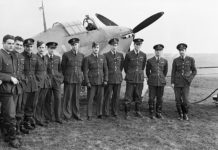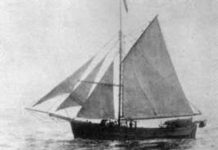The WWII Battle of Hong Kong was short. The vicious, bloody fight for the small British Colony located off the eastern coast of China began on December 8 and ended 18 days later. There were not enough Allied soldiers, not enough Allied equipment to hold the island in the British grasp. On December 25, 1941, Hong Kong was surrendered into the hands of the invading Japanese.
Royal Rifles Exhausted in Battle
By December 23rd, the Japanese gained control of most of the island and they turned their attention to the western village, isthmus and hill of Stanley. The Allies were exhausted from fighting, low on supplies, low on ammunition and overwhelmed with fatigue.
Consent was gained for the troops to have a dearly-needed break, and three platoons of the Royal Rifles from Quebec City found rest in the barracks of Fort Stanley. “Scot, Volunteers, and Middlesex units replaced them at the front,” said Ted Ferguson in “Desperate Siege: The Battle of Hong Kong,” (Doubleday Canada Ltd., Toronto 1980).
Allied Troops Under Attack
The break lasted only a few brief hours. The Japanese were drawing closer and the high ground above Stanley urgently required protection. On ground below the Canadians, a battle raged for the village. “Two Scottish platoons were wiped out, fourteen members of a twenty-eight man Volunteer unit were killed or wounded,” said Ferguson, “and the Rifles lost one half of their peninsula detachment.” The attackers came in enormous waves, using flamethrowers to compel Allied troops out of their positions. Middlesex and Volunteers were forced into hand-to-hand combat, with all wounded. The Allied soldiers rushed to bolster Stanley.
The St. Stephen’s Boy’s School located on a hill above Stanley was transformed into a hospital; patients were tended to in classrooms and hallways by military nurses, orderlies and aides under the leadership of Dr. George Black. On that Christmas Day, Dr. Black chose to keep his patients in the school rather than evacuating before the enemy arrived. A Red Cross flag should give immunity, the doctor reasoned, and he would tell them to leave. Dr. Black was not prepared for the drunken, violent invasion by Japanese troops.
Canadian Troops Massacred on Christmas Day
The good doctor didn’t have a chance. After blocking entry with his arm and stating the building was a hospital, Dr. Black was immediately silenced by a rifle shot to the forehead. Standing beside the doctor, Captain John Whitney was also shot. Flooding into the building, the enemy soldiers repeatedly thrusted their bayonets into the two dead bodies. “Fifty six defenceless soldiers lying in the hallway were hayoneted to death,” Ferguson noted. The horror had only just begun.
Locking several dozen Allied soldiers into a small, lightless storage room, the Japanese captors opened the door every half-hour to drag a few men out to be tortured and then killed. The women were treated no better, stated Ferguson. Some were tortured, placed on top of corpses and gang raped. They were then murdered by bayonet. Other women were raped over and over again.
Soldiers Observed Christmas Day in Hong Kong
In stark opposition, several miles away a small group of soldiers had no idea what was happening. Separated from their unit, the men came across a private home and indulged in Christmas spirit. Other Allied troops scattered across the island found ways to mark the Christmas day, such as the captives from Repulse Bay Hotel sharing beer and soda crackers. No matter how short the moment, Christmas was still celebrated in the hearts of the Allied soldiers.
At 9 a.m. on Christmas Day, the Japanese sent two captured civilians on a mission to the Fortress Headquarters, giving the British an opportunity to surrender. They were permitted a three-hour ceasefire in which to decide. By this time, there was very little left in equipment, phone lines were cut and there was little use in continuing the battle. The Commander of British troops, Major General Christopher Maltby, was ready to surrender Hong Kong to the Japanese and his consultation with Lieutenant Colonel Stewart, commander of the Middlesex troops, did not sway his opinion. Asking Stewart how long he thought his troops could hold off the invaders, Stewart replied, “They’re in a bad way. I’d say an hour at the most.”
British Surrendered Colony to Japan
Maltby made his way to Government House at 3:15 p.m. and made the formal announcement. The British surrendered the colony. “Late on Christmas Day, Governor Sir Mark AitchisonYoung crossed the wreckage-strewn harbour on an MTB,” said Ferguson, “flying a white flag to sign unconditional surrender papers at General Sakai’s headquarters.” The 18-day battle was over for Hong Kong, but the Allied troops were to spend years in unbearable conditions at Japanese concentration camps. Many did not survive.
The battalions of the Winnipeg Grenadiers and Royal Rifles in the Battle of Hong Kong included two nurses, dentists and assistants, three chaplains and others sent to the island. Of the 1,975 troops, 554 of them did not return home. “When war broke out, it was soon clear that the 15,000 Allies didn’t stand much of a chance against some 50,000 Japanese troops, who also had almost complete air and artillery superiority,” said CBC Digital Archives in “Japanese attack Canadian Troops in Hong Kong.” Fighting courageously, the Canadians were mostly young men between ages 17 and 25, new to the art of war. “Many had enlisted a few weeks earlier.”
“The fact that it took the Japanese until Christmas Day to force surrender is a testimony to the brave resistance of the Canadian and other defending troops,” said Veterans Affairs Canada. That dark day in 1941 was dubbed “Black Christmas.”
Sources:
- Ferguson, Ted, “Desperate Siege: The Battle of Hong Kong,” Doubleday Canada Limited, Toronto 1980.
- “Canadians in Hong Kong: the West Brigade,” Veterans Affairs Canada
- “Japanese attack Canadian troops in Hong Kong,” CBC Digital Archives
- Banham, Tony, “The Battle of Hong Kong Background,” Hong Kong Veterans Commemorative Association







